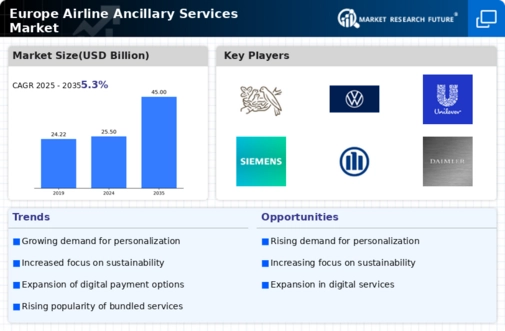Europe Airline Ancillary Services Size
Europe Airline Ancillary Services Market Growth Projections and Opportunities
The Europe airline ancillary services market is shaped by several key factors that influence its growth and evolution. One significant factor is the increasing competition and commoditization of air travel, which has led airlines to explore new revenue streams beyond traditional ticket sales. Ancillary services, including baggage fees, onboard food and beverage sales, seat upgrades, and priority boarding, have emerged as a key source of revenue for airlines in Europe. As airlines face pressure to remain competitive and improve profitability in a challenging operating environment, there is a growing emphasis on optimizing ancillary revenue streams, enhancing customer experience, and leveraging data analytics and personalization techniques to drive ancillary sales and maximize revenue per passenger.
Moreover, changing consumer preferences and behaviors drive market demand for ancillary services in the European airline industry. Travelers increasingly value flexibility, choice, and customization when booking air travel, leading to greater demand for à la carte services and personalized travel experiences. Airlines are responding to these trends by offering a wide range of ancillary products and services that cater to diverse passenger needs and preferences, from Wi-Fi connectivity and in-flight entertainment to travel insurance and airport lounge access. Additionally, loyalty programs and frequent flyer schemes play a crucial role in driving ancillary sales and customer retention, as airlines incentivize passengers to purchase ancillary services and earn rewards points or miles that can be redeemed for future travel or upgrades.
Furthermore, technological advancements and digitalization drive innovation and growth in the Europe airline ancillary services market. Airlines are investing in digital platforms, mobile apps, and e-commerce solutions to enhance the booking process, streamline ancillary sales, and deliver personalized offers and promotions to passengers. Digital technologies enable airlines to collect and analyze customer data, track browsing and purchasing behavior, and target passengers with relevant ancillary offers and recommendations based on their preferences and past travel history. Additionally, artificial intelligence (AI) and machine learning algorithms enable airlines to optimize pricing strategies, predict demand for ancillary services, and dynamically adjust offers and inventory in real-time to maximize revenue and enhance customer satisfaction.
Moreover, regulatory frameworks and industry standards influence market dynamics in the Europe airline ancillary services sector. Aviation regulators and consumer protection agencies in Europe impose regulations and guidelines that govern the transparency, pricing, and disclosure of ancillary fees and charges to passengers. Airlines are required to provide clear and comprehensive information about ancillary services, including pricing, terms and conditions, and optional add-ons, to ensure transparency and consumer choice. Additionally, industry associations, such as the International Air Transport Association (IATA) and the European Travel Commission (ETC), establish standards and best practices for ancillary sales and distribution, promoting industry-wide collaboration and innovation in ancillary revenue management.
Furthermore, market factors such as economic conditions, travel trends, and competitive dynamics influence ancillary revenue strategies and market growth in Europe. Economic factors, such as GDP growth, consumer spending, and business travel demand, impact passenger willingness to spend on ancillary services and discretionary travel expenses. Travel trends, such as the rise of low-cost carriers, leisure travel, and digital nomadism, create opportunities for airlines to expand their ancillary offerings and capture a larger share of wallet from passengers. Additionally, competitive dynamics, including price competition, route expansion, and market consolidation, drive innovation and differentiation in ancillary product offerings and pricing strategies, as airlines seek to attract and retain customers in a highly competitive market environment.
Moreover, market segmentation and targeting strategies play a crucial role in maximizing ancillary revenue opportunities for airlines in Europe. Airlines analyze passenger demographics, travel preferences, and booking behavior to identify high-yield customer segments and tailor ancillary offers and promotions to meet their needs and preferences. For example, business travelers may value priority boarding, lounge access, and flexible ticketing options, while leisure travelers may be more interested in in-flight entertainment, Wi-Fi connectivity, and vacation packages. By segmenting the market and targeting specific customer segments with relevant ancillary offers and incentives, airlines can increase ancillary sales, enhance customer satisfaction, and drive revenue growth in the Europe airline ancillary services market.












Leave a Comment